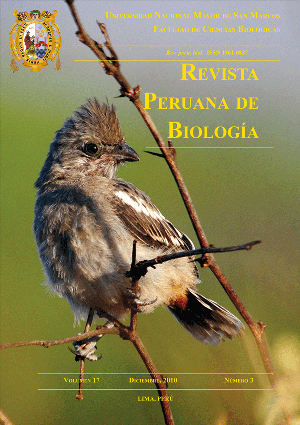Citoprotective effect of camu-camu Myrciaria dubia on three celular lines of mouse exposed in vivo to potassium bromate
DOI:
https://doi.org/10.15381/rpb.v17i3.17Keywords:
Camu-camu, Myrciaria dubia, Potassium bromate, genotoxicity, alkaline comet assay.Abstract
It was evaluated in vivo the cytoprotective capacity of the fruit of Myrciaria dubia H.B.K. MC VAUGH "Camu- camu (Myrtacea) against mutagenic damage caused by potassium bromate (68.5 mg/k) on three mouse cell lines (liver, kidney and blood cells). Mice (n = 120) were divided into three groups which drank ad libitum: distilled water; TI (negative control) and TIII (positive control), the TII group (positive control) drank the aque- ous extract (2 %) of the fruit of Camu-camu. After ten days, only the TII and TIII groups were intraperitoneally injected with a single dose of KBr03(68.5 mg/k). The camu-camu treatment lasted 35 days more, where they were euthanized to determine the frequency of DNA damage by means of the alkaline comet assay protocol. It was observed in all cell lines a cytoprotective effect of camu-camu (p<0.05) with respect with the negative control. The DNA-damaging effects of oxidative KBrO3 action is inhibited by the 2% aqueous extract of camu- camu fruit, probably by the presence of antioxidants such as ascorbic acid and flavonoids.Downloads
Downloads
Published
Issue
Section
License
Copyright (c) 2010 Alvis Rafael, José Pino, José Gonzáles, Juan C. Francia, Betty Shiga

This work is licensed under a Creative Commons Attribution-NonCommercial-ShareAlike 4.0 International License.
AUTHORS RETAIN THEIR RIGHTS:
a. Authors retain their trade mark rights and patent, and also on any process or procedure described in the article.
b. Authors retain their right to share, copy, distribute, perform and publicly communicate their article (eg, to place their article in an institutional repository or publish it in a book), with an acknowledgment of its initial publication in the Revista Peruana de Biologia.
c. Authors retain theirs right to make a subsequent publication of their work, to use the article or any part thereof (eg a compilation of his papers, lecture notes, thesis, or a book), always indicating its initial publication in the Revista Peruana de Biologia (the originator of the work, journal, volume, number and date).






